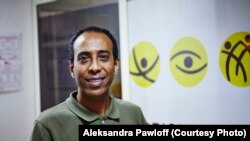The federation of NGOs known as Light for the World is committed to stopping the transmission of the eye disease trachoma in the northern Ethiopian region of Tigray. The federation’s strategy includes mapping the mountainous region, and teaching people how to apply the SAFE strategy -- Surgery; Antibiotics; Facial cleanliness and Environmental change.
The organization says it has carried out mapping in Ethiopia’s Tigray and Somali regions to collect and analyze data that will help them treat the 4.5 million people who live in places where trachoma is endemic.
Dr. Amir Bedri Kello, senior consultant for Light for the World, explained that mapping is important in determining the prevalence of trachoma, which in turn allows the SAFE strategy to be applied more effectively.
“Tigray region is one of the regions that has very high endemicity for trachoma. Almost 4.4 million people in Tigray live in trachoma endemic areas. From the region itself we have a backlog of over 30,000 trachoma-- trichiasis cases—this is the late complication of trachoma whereby you have inverted lashes that touch the cornea. It is a painful condition that will eventually lead to blindness unless it is treated by surgical intervention,” explained Dr. Bedri.
The biggest focus for 2015 is on districts with the highest rates of trachoma and trichiasis.
“When you have very high trachoma infection rates which are 30% and above, this would require five years of intervention with full WHO recommended SAFE strategy. That would mean for 2015 that we would be doing surgery for delayed complications of trachoma, over 3,500 trachoma surgeries for next year, (2015), and also implementing activities that would promote hygiene and sanitation,” Dr. Bedri pointed out.
He also emphasized that the biggest challenge of these activities will be behavioral changes towards personal hygiene and sanitation. He said the medical aspect of treating trachoma is readily accepted. However the doctor said when it comes to teaching the importance of personal hygiene and environmental sanitation, efforts are more challenging.
“It requires a lot of extensive health education, provisional hardware, meaning construction of latrines, water points, but also having to convince the population to change their behavior to better sanitation and hygiene,” said Bedri.










